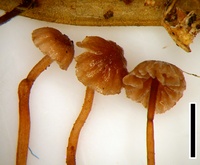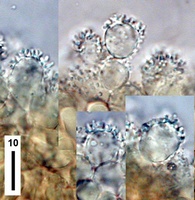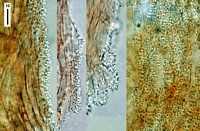|
 Marasmius aurantiobasalis Marasmius aurantiobasalis
BiostatusPresent in region - Indigenous. Non endemic
Images (click to enlarge)
Caption: scale=1mm
Owner: J.A. Cooper | 
Caption: cheilocystidia
Owner: J.A. Cooper | 
Caption: cap hyphae
Owner: J.A. Cooper |
Article: Desjardin, D.E.; Horak, E. (1997). Marasmius and Gloiocephala in the South Pacific Region: Papua New Guinea, New Caledonia, and New Zealand taxa. Bibliotheca Mycologica 168: 152 p.
Description: Pi1eus 2-6 mm diam, hemispherical to convex when young, expanding with age to plano-convex;
disc with or without an inconspicuous obtuse papilla; margin subplicate; surface dull, dry, glabrous
to minutely innately fibrillose; disc brown, pale reddish brown elsewhere. Texture membranaceous,
tough; context thin.- Lamellae subfree to adnexed, subdistant (11-13) with 1-2 series of lamellulae,
narrow, white to cream with pale reddish tones; edges even, concolorous.- Stipe 15-30 x 0.3-0.5
mm, central, cylindrical, equal, glabrous, tough, insititious; orangish yellow overall, base
developing pale reddish orange tones in age; with scattered yellow, wiry rhizomorphs.- Odor and
taste not distinctive.
Basidiospores (5.5-)6.0-7.5 x (2.5-)3.0-3.5 µm, narrowly ellipsoid, smooth, thin-walled, hyaline,
inamyloid-. Basidia 20-26 x 4-6 µm, cylindrical to subclavate, 4-spored, clamped.- Cheilocystidia
common, (15)20-40 x 8-15(-25) µm, clavate, broadly clavate or sphaeropedunculate with numerous
diverticula over the upper half, hyaline, thin-walled or apically thick-walled; diverticula 2-6 x 1-2
µm, cylindrical or irregular in outline, rarely forked, hyaline.- Pleurocystidia absent.- Pileipellis a
subhymeniform layer of clavate to irregular, sometimes lobed cells 15-25 x 6-20 µm, densely
diverticulate, yellowish brown, thin-walled; diverticula 2-7 x 1-21 µm, cylindrical or irregular in
outline, rarely forked, pale yellowish brown.Pi1ea1 trama weakly dextrinoid; lamellar trama
inamyloid.- Stipe tissue monomitic; cortical hyphae smooth, golden, strongly dextrinoid; medullary
hyphae hyaline, dextrinoid.- Cau1ocystidia absent.- Clamp connections present.
Habitat: Habit, habitat and distribution.- Solitary in groups, on rotting leaves of Nothofagus fusca (Fagaceae;
holotype), Aristotelia serrata (Elaeocarpaceae), or Laurelia novaezelandiae (Lauraceae). Java, New
Zealand.
Notes: Marasmius aurantiobasalis is characterized by a reddish brown pileus, subdistant, non-marginate
lamellae, a glabrous, orangish yellow stipe associated with yellow wiry rhizomorphs, relatively
narrow basidiospores, broadly clavate and densely diverticulate cheilocystidia, a subhymeniform
pileipellis of diverticulate, terminal cells, no caulocystidia, and growth on leaves of dicotyledonous
trees. The orangish yellow stipe contrasting with a reddish brown pileus is reminiscent of M.
acicularis Berk. and M. straminipes Peck. Marasmius acicularis, described from the Bonin Islands,
differs in forming a pileipellis composed of a hymeniform layer of Siccus-type cells and
consequently belongs in sect. Sicci (Isotype, FH!). Marasmius straminipes from eastern North
America differs in forming a paler pileus (often cream to pale greyish brown), slightly longer and
broader basidiospores (6.5-10 x 3.2-4.5 µm), and more irregularly shaped and narrower
cheilocystidia (Holotype, NYS!; see Desjardin & Petersen 1989b). A variety from New Caledonia
with hispidulous stipe and numerous caulocystidia is described as M. aurantiobasalis var.
hispidipes in Part I of this series on South Pacific marasmioid fungi.
|